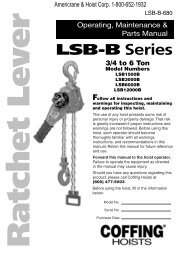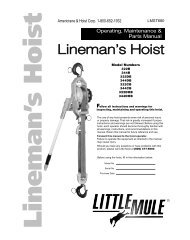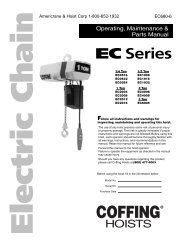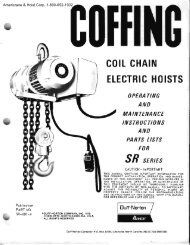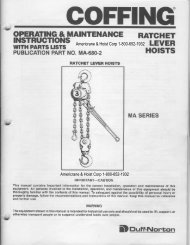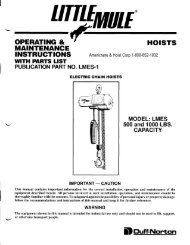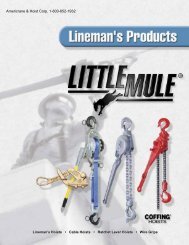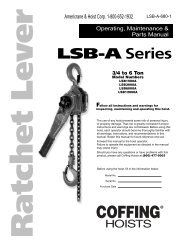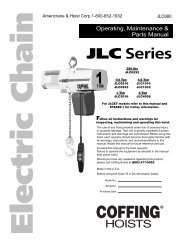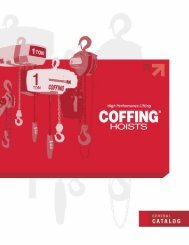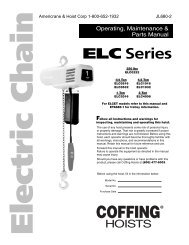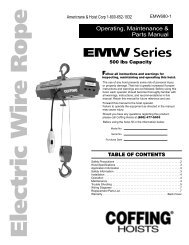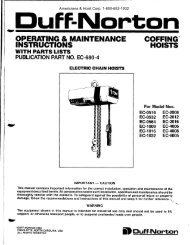ELCMT Series, JLMT 680-1 - Coffing Hoists, Coffing Hoist Parts
ELCMT Series, JLMT 680-1 - Coffing Hoists, Coffing Hoist Parts
ELCMT Series, JLMT 680-1 - Coffing Hoists, Coffing Hoist Parts
- No tags were found...
Create successful ePaper yourself
Turn your PDF publications into a flip-book with our unique Google optimized e-Paper software.
Country Club RoadP.O. Box 779Wadesboro, NC 28170 USATEL: (800) 477-5003FAX: (800) 374-6853SAFETY INFORMATIONFor safe use of the electric chain hoist and motorized trolley,adherence to the following precautions is imperative. Allpersons concerned with the installation, operation, inspectionand maintenance of the hoist and trolley are urged to read theAmerican Society of Mechanical Engineers (ASME) SafetyCode B30.16, “Overhead <strong><strong>Hoist</strong>s</strong> (Underhung).”1. Follow all local electrical and safety codes, as well as theNational Electrical Code (NEC) and the OccupationalSafety and Health Act (OSHA) in the United States.2. Before installing the hoist and trolley unit, be sure that thebeam and the supporting structure have adequate strengthfor the capacity of the hoist. If in doubt, consult a qualifiedstructural engineer.3. Open-ended beams must have end stops to prevent thetrolley from running off the beam. In the event of a collision,the stops should only contact the side plate bumpers.4. The hoist and trolley must be adequately grounded. Thepower and ground connections are made at the trolleymotor junction box (green wire is ground), or if supplied, thetrolley control box.5. Make certain that the power source conforms to therequirements of your equipment.6. Three-phase power connections must be made such thatthe hoist runs in the correct direction when pushing the“UP” or “DOWN” buttons (See ELECTRICALCONNECTIONS, page 6).7. Power must be supplied to the unit in a manner that willensure that power cables, if used, do not develop kinks orcome in harms way. Do not allow cables to come in contactwith oil, grease, hot surfaces or chemicals.8. The hoist and trolley are designed for vertical lifting only.Loads should be located directly under the hoist. Sideloading can damage the unit as well as endanger lifeand limb.9. Do not lift loads in excess of the rated capacity.10. Do not use the hoist and trolley to lift and transport peopleor to move loads over people. Stand clear when lifting aload and be sure that all personnel are clear and awarebefore moving a load in their area.11. The operator should have a clear view of the load anytimeit is moving and should be sure that the load does notcontact any obstructions. Never leave a suspended loadunattended.12. Always allow the trolley to coast to a stop in the direction oftravel before reversing its direction. Reversing or “plugging”to stop the trolley causes overheating of the trolley motorand causes the load to sway.13. Inspect the unit daily before operating the hoist.14. Cluttered areas and benches invite accidents.15. The operator should not engage in any practice which willdivert his attention while operating the hoist.16. Do not attempt to operate hoist beyond normal maximumlift range.17. Do not operate hoist with twisted or damaged chain.18. Do not operate a damaged or malfunctioning hoist untilnecessary adjustments or repairs have been made.19. Always remove load before making repairs.20. Do not remove or obscure capacity or warning decals.Always disconnect power source before working onor near a hoist or its connected load. If the powerdisconnect point is out of sight, lock it in the openposition and tag to prevent unexpected applicationof power.INSTALLATION1. Before installing the hoist and trolley, review and adhere tothe following precautions.a. Be sure that the beam and the supporting structure haveadequate strength for the capacity of the hoist. If in doubt,consult a qualified structural engineer.b. Provide proper branch circuit protection for the hoist asrecommended in the National Electrical Code.c. The power supply voltage should be within plus or minus10% of the voltage for which the unit is wired. Refer to thehoist and trolley motor nameplates for information onthe full load amperage. It is critical to use adequatesized power cables, especially with 1-phase hoists (SeeTable 4, page 14). Be sure dual voltage hoists areconnected or wired to correspond with your power supply(See ELECTRICAL CONNECTIONS, page 6).d. The installation area must provide operating conditions forthe operator including sufficient room for the operator andother personnel to stand clear of the load at all times.e. For installations where the slack chain hanging from theunit may be objectionable or hazardous, the use of achain container is recommended. See CHAINCONTAINER, pages 6 & 7.INITIAL LUBRICATIONLubricate the trolley wheel gears with NLGI-2 or heaviergrease. <strong><strong>Hoist</strong>s</strong> are shipped with the load chain prelubricated.If necessary, apply SAE 90 gear oil.TROLLEY MOUNTING TO BEAMRefer to Figure 11.1. <strong>Coffing</strong> <strong>ELCMT</strong> models are designed to fit beam flangewidths in the range of 3.00 to 6" as a standard. Wider beamsup to 9" and patented track beams can be fit with optionalload pins and/or wheels. Be sure that the flange width of therunway beam is within the adjustment range.The unit is shipped assembled with the trolley set for aflange width of 3.33" unless otherwise specified whenordering. If adjustment is required, place the hoist and trolleyunit onto a worktable and follow the steps below. Be surethat power is not connected to the unit.a. Adjusting to a particular beam size is accomplished bylocating the thick (.135”) and thin (.075”) washers asshown (See Figure 11, page 16). Begin by removing theload pin nuts on the plain side of the trolley (1 1 /16" wrench5



